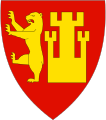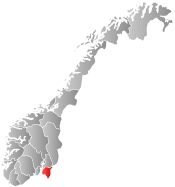Fredrikstad
| Fredrikstad kommune | |||
|---|---|---|---|
| Municipality | |||
|
Riverside promenade in Fredrikstad | |||
| |||
 Fredrikstad within Østfold | |||
| Coordinates: 59°12′19″N 10°57′0″E / 59.20528°N 10.95000°ECoordinates: 59°12′19″N 10°57′0″E / 59.20528°N 10.95000°E | |||
| Country | Norway | ||
| County | Østfold | ||
| District | Eastern Norway | ||
| Administrative centre | Fredrikstad | ||
| Government | |||
| • Mayor (2011) | Jon Ivar Nygård (Ap) | ||
| Area | |||
| • Total | 285.9 km2 (110.4 sq mi) | ||
| • Land | 283 km2 (109 sq mi) | ||
| Area rank | 283 in Norway | ||
| Population (2015) | |||
| • Total | 78,428 | ||
| • Rank | 6 in Norway | ||
| • Density | 249/km2 (640/sq mi) | ||
| • Change (10 years) | 7.7 % | ||
| Time zone | CET (UTC+1) | ||
| • Summer (DST) | CEST (UTC+2) | ||
| ISO 3166 code | NO-0106 | ||
| Official language form | Bokmål | ||
| Website |
www | ||
|
| |||

Fredrikstad (![]() listen ; previously Frederiksstad; literally Fredrik's Town) is a city and municipality in Østfold county, Norway. The administrative centre of the municipality is the city of Fredrikstad.
listen ; previously Frederiksstad; literally Fredrik's Town) is a city and municipality in Østfold county, Norway. The administrative centre of the municipality is the city of Fredrikstad.
The city of Fredrikstad was founded in 1567 by King Frederick II, and established as a municipality on 1 January 1838 (see formannskapsdistrikt). The rural municipality of Glemmen was merged with Fredrikstad on 1 January 1964. The rural municipalities of Borge, Onsøy, Kråkerøy, and Rolvsøy were merged with Fredrikstad on 1 January 1994.
The city straddles the river Glomma where it meets the Skagerrak. Along with neighboring Sarpsborg, Fredrikstad forms the fifth largest city in Norway: Fredrikstad/Sarpsborg. As of 1 January 2013, according to Statistics Norway, these two municipalities have a total population of 128,916 with 75,583 in Fredrikstad and 53,333 in Sarpsborg.
Fredrikstad was built at the mouth of Glomma as a replacement after Sarpsborg (15 kilometres (9 miles) upstream) was burned down by the Swedes. Almost half the population of Sarpsborg stayed behind, and rebuilt their old town at its original site.
The city centre is on the west bank of the Glomma, while the old town on the east bank is Northern Europe's best preserved fortified town.
Fredrikstad used to have a large sawmill industry and was an important harbour for timber export, then later on shipbuilding, until the main yard was closed in the 1980s. The main industries are currently various chemical plants and other light industry.
In 2005, Fredrikstad was the final host port for the Tall Ships' Race, attracting thousands to the city.
General information
Name
The city was named after the Danish king Frederick II in 1569. The last element stad means "city".
Prior to 1877, the name was spelled Frederiksstad, then from 1877–1888 it was written as Fredriksstad, and finally since 1889 it has been spelled in its current form: Fredrikstad.
Coat-of-arms
The coat-of-arms is from modern times. They were granted on 21 April 1967. The old arms are based on the oldest known seal of the city, which dates from 1610. They showed a fortress being guarded by a bear. Strangely, Fredrikstad had no fortifications in 1610 (it received some at the end of the 17th century). Fredrikstad was founded by citizens of Sarpsborg and both the fortress and the bear are taken from the old arms of Sarpsborg. The composition of the seal was also used as arms since the beginning of the 19th century. The new arms were granted at the 400th anniversary of the city in 1967 and show a more modern variation on the fortress and bear.[1]
History
After Sarpsborg was burned to the ground during the Northern Seven Years' War, the ruling king, Frederik II of Denmark, decided by royal decree to rebuild the city 15 kilometres (9 mi) south of the original location. This new site's proximity to the sea and the accessible open land surrounding it made it a better location than the old one. The name Fredrikstad was first used in a letter from the King dated 6 February 1569. The temporary fortification built during the Hannibal War (1644–1645) between Sweden and Denmark-Norway, became permanent in the 1660s.
The work on the fortifications was first led by William de Coucheron and later Johan Caspar von Cicignon. During the next 60 years, several fortifications at the Fredrikstad Fortress were built, including Isegran, Kongsten, and Cicignon. In 1735, a suburb on the western side of Glomma, Vestsiden, was founded. This part later grew faster than the old city, and became the dominant city centre. Most of the buildings in the old city burned down during a fire in 1764.
In the 1840s, timber exporting from Fredrikstad started to gain momentum. In the 1860s, several steam powered saws were built along the river, and in 1879 the railway reached Fredrikstad, leading to further growth. With the decline of the timber exports as a result of the modernization of wood-processing industries in the early 1900s, Fredrikstad's production changed to other types of products. It later became one of Norway's most important industrial centres, famous for its large shipyard, Fredrikstad Mekaniske Verksted.
Fredrikstad Museum
Fredrikstad Museum is located in Old Fredrikstad. The museum shows the history of the city and the surrounding region. The museum also manages Elingaard Manor in Onsøy and Torgauten Fort. Fredrikstad Museum was founded in 1903. Since 2003, the museum's management has been located in Tøihuset in Old Town.[2]
Sport
Fredrikstad is home to nine time Norwegian football champions Fredrikstad FK who play at the Fredrikstad Stadion.
Fredrikstad also hosts a number of Norwegian floorball teams, like Slevik IBK, Fredrikstad IBK and St. Croix Pirates.
They also have a hockey team called Stjernen Hockey
Notable residents
- Waldemar Ager, Norwegian-American writer
- Petronella Barker, Norwegian actress
- Jørn Christensen, Norwegian artist and producer.
- Colin Coates, International Speed Skating Olympian Speed Skating.
- Johan Caspar von Cicignon, General, engineer and city planner
- Johannes Wilhelm Christian Dietrichson, Lutheran Minister
- Tarik Elyounoussi, male footballer (soccer), playing for Fredrikstad FK and the Norwegian national team
- Albert Andriessen Bradt, Norwegian-American settler in New Netherland
- Stephan Groth, lead singer and founder of Apoptygma Berzerk singer
- Ragnvald Marensius Gundersen, member of Parliament and mayor of Fredrikstad 1945–1965
- Hans Nielsen Hauge, revivalist Norwegian preacher for the Hauge Synod
- Herman Hebler, Norwegian printmaker and graphic artist
- Isabell Herlovsen, female footballer (soccer) in the Norway national team.
- Andy LaPlegua, Industrial Artist, Combichrist, Icon of Coil, Panzer AG, DJ Scandy, Thorvald Brudvik
- Katti Anker Møller, feminist and advocate for reproductive rights
- Egil "Drillo" Olsen, successful manager of Norwegian national football team in the 90's.
- Ole Peter Petersen, founder of Methodism in Norway
- Johan Oscar Smith, Norwegian Christian leader and founder of Brunstad Christian Church
- Dennis Storhøi, Norwegian actor
- Harald Zwart, Norwegian film director
- Bernt Karsten Øksendal, Norwegian mathematician
- Jon Mostad, Norwegian composer
- Jørn Andersen, Norwegian football manager
- Abdullah Chaib, Norwegian ISIS member killed in action while fighting in Syria
- Abu Edelbijev, Norwegian ISIS member killed in action while fighting Kurdish forces in Kobani, Syria
| Ancestry | Number |
|---|---|
| | 1,916 |
| | 1,298 |
| | 971 |
| | 775 |
| | 672 |
| | 606 |
| | 466 |
| | 340 |
| | 330 |
| | 273 |
International relations
Twin towns – sister cities
The following cities are twinned with Fredrikstad:[4]
References
Footnotes
- ↑ Norske Kommunevåpen (1990). "Nye kommunevåbener i Norden". Retrieved 2008-12-13.
- ↑ Fredrikstad museum (Østfoldmuseene Org)
- ↑ "Immigrants and Norwegian-born to immigrant parents, by immigration category, country background and percentages of the population". ssb.no. Retrieved 29 June 2015.
- ↑ "Våre vennskapsbyer" (in Norwegian). Fredrikstad kommune. Archived from the original on 1 December 2007. Retrieved 2008-12-16.
- ↑ "Aalborg Twin Towns". Europeprize.net. Retrieved 19 August 2013.
- ↑ Hassinen, Raino. "Kotka - International co-operation: Twin Cities". City of Kotka. Retrieved 2013-10-22.
Literature
- Aschehougs Konversasjonsleksikon, Bind 7. H. Aschehoug & Co, Oslo, 1969.
External links
| Wikimedia Commons has media related to Fredrikstad. |
| Look up Fredrikstad in Wiktionary, the free dictionary. |
 Fredrikstad travel guide from Wikivoyage
Fredrikstad travel guide from Wikivoyage- Bratt Family


